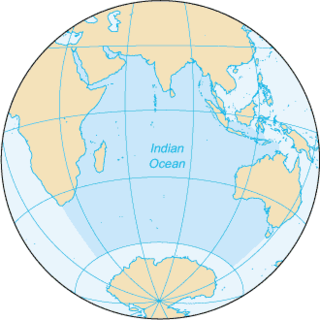
The Syngnathidae is a family of fish which includes seahorses, pipefishes, and seadragons. The name is derived from Greek, σύν (syn), meaning "together", and γνάθος (gnathos), meaning "jaw". This fused jaw trait is something the entire family has in common.

Syngnathus is a genus of fish in the family Syngnathidae found in marine, brackish and sometimes fresh waters of the Atlantic, Indian and Pacific Ocean. Fossils of these species are found from the Oligocene to the Pleistocene. They are known from various localities of Greece, Italy, Germany and United States.

Stigmatopora is a genus of pipefishes native to the Indian and Pacific Oceans.
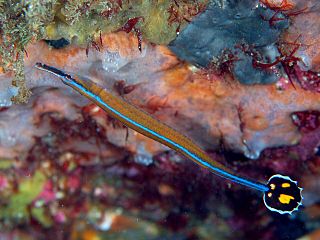
Doryrhamphus and Dunckerocampus, popularly known as flagtail pipefish, are two genera of fishes in the Syngnathidae family. They are found in warm, relatively shallow waters of the Indo-Pacific, with a single species, D. paulus, in the eastern Pacific. Most of these pipefishes are very colourful, and are fairly popular in the marine aquarium hobby despite requiring special care and not being recommended for beginners.
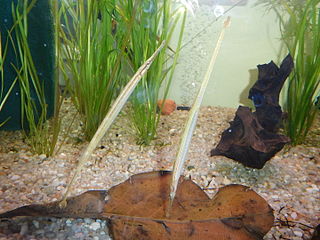
Microphis is a genus of pipefishes within the family Syngnathidae. Members of this genus are notable among the Syngnathidae for residing in mainly fresh and brackish waters. Adults breed in coastal rivers, streams, or lakes, and fertilized eggs are carried by the male pipefish in a brood pouch extending along his entire ventral surface.

Corythoichthys is a genus of pipefishes of the family Syngnathidae. All species in the genus are found in the tropical Indian and Pacific Oceans on reefs or rubble bottoms. Relationships and taxonomy within the genus are still in debate, but there may be at least 23 species.

Dunckerocampus is a genus of pipefishes one of two genera known as the flagtail pipefishes. This genus is native to the Indian and Pacific Oceans where they are usually found in reef environments. These species are elongated and have a maximum length between 10 and 20 centimetres, with D. chapmani being the only species with a maximum length below 15 centimetres (5.9 in). Their tail is red with a whitish edge, and in some species there is a white or yellow spot in the center. All except D. baldwini have vertical red/brown and yellow/white stripes on their body.

Doryrhamphus is a genus of pipefishes, one of the two genera colloquially known as flagtail pipefishes and are popular in the aquarium trade. The members of this genus are native to the Indian and Pacific Oceans where they inhabit reef environments. The species in this genus have a maximum length of 14 centimetres (5.5 in) or less, with D. janssi being the only species that surpasses 8.5 centimetres (3.3 in). Most species have a horizontal blue line along their body, and all have a whitish-edged tail that is marked contrastingly with black, red or yellow.
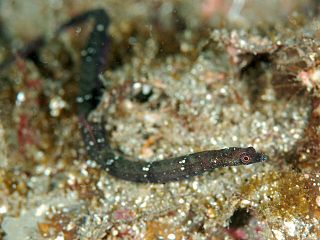
Halicampus is a genus of pipefishes of the family Syngnathidae, containing 12 described species.

Siokunichthys is a genus of pipefishes native to the Indian and Pacific Oceans. One species, Siokunichthys nigrolineatus, has a commensal relationship with mushroom corals of the genus Fungia.
Choeroichthys is a genus of pipefishes of the family Syngnathidae native to the Indian and Pacific Oceans.
Hippichthys is a genus of pipefishes native to the Indian and Pacific Oceans and the landmasses around them. This genus contains freshwater, brackish water and marine species.
Doryichthys, river pipefish, is a genus of Asian freshwater pipefishes.
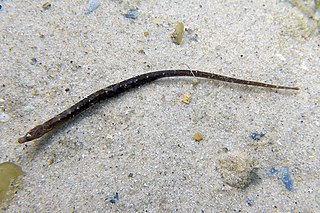
Campichthys is a genus of pipefishes native to the Indian and Pacific Oceans.

Cosmocampus is a genus of pipefishes.

Lissocampus is a genus of pipefishes mostly native to the Indian Ocean. One species (L. bannwarthi) is only known to occur in the Gulf of Aqaba and the Gulf of Suez and one species (L. filum) occurs in the Pacific Ocean around New Zealand and the Chatham Islands. The remaining species are endemic to Australia.

Trachyrhamphus serratus, also known as the crested pipefish or saw pipefish, is a species of marine fish belonging to the family Syngnathidae. They can be found in Sargassum beds, mud, and sandy habitats from Southern India to South Korea and Japan. This species is observed at depths ranging from 15 to 100 meters.


